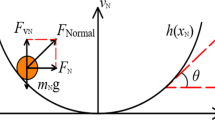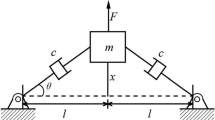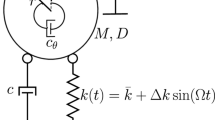Conclusions
-
1.
An ordinary spring suspension increases natural unisochronism of pendulum oscillations. This is due to the fact that the axis of its rotation (fictitious point) is displaced upward with a rising amplitude.
-
2.
The axis of rotation of a pendulum attached to an isochronic suspension is displaced downward with a rising amplitude, thus reducing the length of the pendulum. This is the difference in principle between an ordinary and an isochronic suspension.
-
3.
The computations provided above show that the lowering of the rotation axis of a pendulum attached to an isochronic suspension is sufficient in order to provide a cycloidal trajectory for the pendulum's center of gravity, i.e., to make the oscillations isochronic.
-
4.
The large unisochronism of pendulum oscillations observed at small amplitudes is due to the indeterminate position of the rotation axis of the pendulum when it passes through its position of balance.
Similar content being viewed by others
Literature cited
L. P. Shishelov, Mechanics of a Watch Mechanism, Kiev, Kubuch (1935).
Rights and permissions
About this article
Cite this article
Fedchenko, F.M., Fleer, A.G. Spring suspensions for a pendulum. Meas Tech 9, 1012–1016 (1966). https://doi.org/10.1007/BF00988873
Issue Date:
DOI: https://doi.org/10.1007/BF00988873




